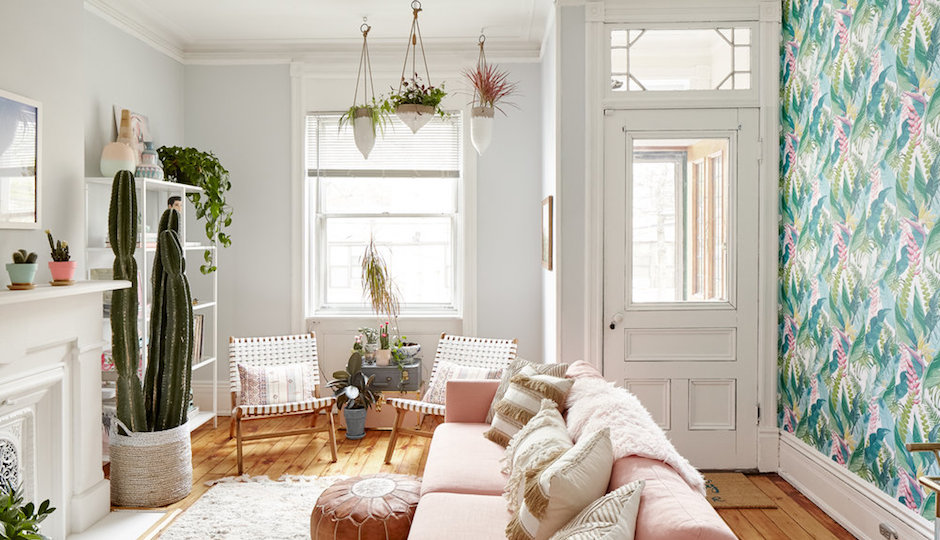This Designer Lets You Buy Her Services in Bite-Sized Pieces
Havertown-based Michelle Gage is on the cutting edge of a growing interior design trend: Pay for the design work you need as you need it.

This Palm Springs-inspired living room features some of Gage’s trademark design elements: colorful wall prints, appropriate greenery and vintage objects. | Photo: Michelle Gage
Update, Dec. 5, 2018: Michelle Gage has made internal changes to the way she does business since this article was published. All client inquiries should be directed to her.
Have a bedroom where you have the furniture you want, but you want to give it some extra oomph?
Many people in this situation would turn to an interior designer for help. And most interior designers would tell them how much it would cost to have the room done up right.
Not Michelle Gage. Instead, she would give you an estimate of how much time it would take to tackle your problem and charge you for that many hours.
The Havertown-based interior designer is on the cutting edge of a trend in the interior design field: pay-as-you-go design services where clients are billed by the hour. This, she says, saves clients money because it lets them tailor their work to their needs.
“You can break the project up to be whatever you want it to be,” she says. “For instance, if you’re looking for a dresser for your bedroom, or a dining table for your dining room, you can do that. If you have a room you think is 80 percent complete but just need help with that last piece, you can do that too.”
“No markups, no hidden fees”
This flexible approach stands in stark contrast to the traditional service model, which usually assumes that the client will use the designer to both furnish and arrange the space from start to finish. Doing this has its advantages in many cases, for interior designers often have access to objects and furnishings not generally available to the public at large and can combine them creatively. But it might cost you in some cases. Gage described the process thus: “They quote you for the entire project, and based on what they hope to get, they may include a markup for the product. They use their trade discount and pocket the difference themselves.
“With the hourly model, there’s no markups and no hidden fees. Thus, if you’re doing a single room and only doing three hours of styling, you can save money” compared to paying a flat fee for the entire room.
Gage got the design bug early in life. She carried a notebook full of floor plans and design ideas with her wherever she went. And as her website bio states, “Whether you wanted it or not, I was always there to offer a friendly floor plan fix.”
This ultimately led her to pursue a bachelor of science degree in interior design from Virginia Tech. She came to Philadelphia to work as a home merchant in Anthropologie headquarters, buying all sorts of home decor items for the chain.
Gage struck out on her own about two years ago, running her business out of her Havertown home. “It’s a great plus,” she says of the location. “It gets me close to clients in the city and close to clients on the Main Line.”
“A space that looks like the client”
Her goal for every project, whether big or small, is to make it look as though she didn’t do a thing. “My goal is to have a space that looks like the client,” she says. “It shouldn’t look like the designer touched it. It should look like it’s been curated by them over the years.”
That’s especially true, she adds, when the client’s sensibilities and her own don’t mesh. She enjoys doing such jobs, saying they’re “a nice challenge.”

Michelle Gage
Her own sensibilities run towards the playful and the polychromatic. “Every client has a personal preference, so I lean towards a space that reflects them, but where I can, I use playful prints, and I also like to use vintage items,” she says. “For instance, a vintage trunk at the foot of your bed adds an extra layer of depth to the space.”
Gage has roamed the world in search of vintage finds: “I’ve done Brimfield, a great antique market in Western Massachusetts,” she says. “I’ve done the Rose Bowl in LA, and I went to the Paris flea market a few months ago. But I also do flea markets and vintage here. There’s lots of great stuff to choose from.”
Her local favorites? “I love Philadelphia Salvage,” she says. “They have a lot of great salvaged architectural material. So if you have, say, an older home and want to replace a modern door that a previous owner put in, you can find it there. They’re the coolest people and they find the best stuff.”
Other local shops specializing in vintage finds she favors include Hoof & Antler in Old City, Isabella Sparrow in Chestnut Hill (“a great place to get vintage decor in smaller pieces”) and the Clover Market seasonal home decor markets that operate in Bryn Mawr, Chestnut Hill and Kennett Square in Pennsylvania and Collingswood in New Jersey.
Gage even operates her own online vintage shop on Chairish, The Early Bird Vintage by Michelle Gage.
And she’s also not shy about offering tips and advice for those who’d rather do their design work themselves: she writes articles regularly for Apartment Therapy, which has also run features on rooms in her own home.
But if you’d rather work directly with the source of all this inspiration, you should visit her own website and arrange for a consultation.
Updated Sept. 3, 5:38 a.m., to correct the name of the Massachusetts flea market.
Follow Sandy Smith on Twitter.


